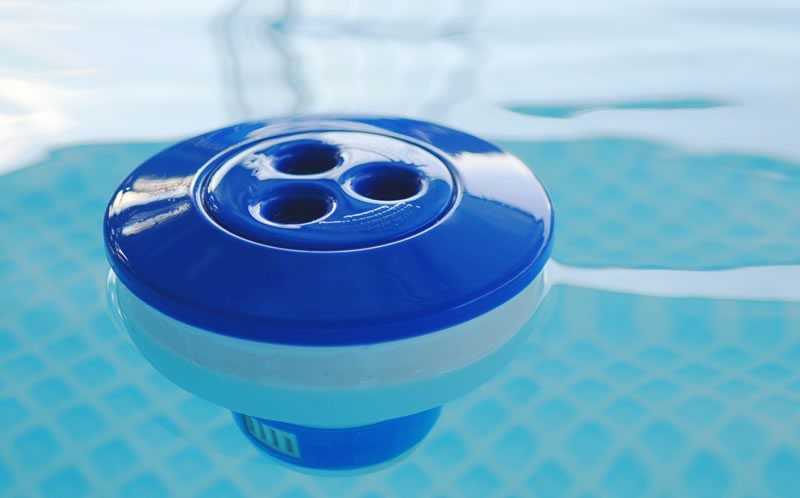Chlorine in its various forms is the most commonly used pool disinfectant. In addition to killing bacteria, chlorine helps to kill algae and destroy waste material not removed by the filter system. In its natural or elemental state, chlorine is a gas. But chlorine gas is very toxic and hard to handle safely. This is why chlorine is combined with other compounds to form several liquids and solids which are effective sanitizers and safer to handle than chlorine gas. The use of chlorine in a swimming pool as a sanitizer has long been recognized.
No matter what form of chlorine you use, it’s primary purpose is to combine with water to form what is called FREE CHLORINE or “Hypochlorous Acid”(HA) . It is only the chlorine in the form of HA that sanitizes and disinfects. Over 90% of the sanitizing power of any chlorine comes in form of the all important HA. HA has certain limitations. It tends to be unstable in the presence of sunlight, high temperatures and low ph levels. These conditions cause rapid chlorine loss. The amount of Hypochlorous Acid (disinfectant) your chlorine forms is dependent on the pool water Ph. As the Ph increases, the percentage of chlorine that forms into disinfectant decreases. For example, at a Ph of “8”, only 23% of the chlorine is forming disinfectant. This is one reason why Ph should be monitored.
All swimming pools can develop “CHLORINE DEMAND” when insufficient chlorine is present. Dissolved iron, bacteria, perspiration, algae, pollen spores, and other organic materials create a “CHLORINE DEMAND” in pool water. If enough chlorine were added to form the suitable amount of HA to oxidize all of the pollutants present, a “CHLORINE DEMAND” would no longer exist.
TYPES OF CHLORINE
Calcium Hypochlorite is a dry “Unstabilized” granular product with a calcium base. It is 65% available chlorine with a Ph of 12 to 13. It is slow dissolving and should be dissolved in a bucket of water prior to adding to the pool. Constant use of a calcium based chlorine will increase the calcium hardness and cause the Ph to climb upward. In the presence of heat and sunlight, it is relatively unstable and precipitates out of the water rapidly.
Sodium Hypochlorite is a “Unstabilized” liquid chlorine used in many large commercial as well as smaller private pools where handling and storage is not a problem. It has 10% to 15% available chlorine with a Ph of 13 to 14. It does not store well in heat or sunlight and should be used as soon as possible after it is manufactured. The best results are obtained when it is fed automatically through a sodium hypochlorite feeder directly into the water lines. When in the pool water, liquid chlorine is adversely affected by sunlight. For this reason it is best if you only use liquid when a well balanced Stabilizer reading is present. This product is sold fresh at 10-12% available chlorine in 2.5 gallon yellow jugs.
Lithium Hypochlorite is an “Unstabilized” granular fast dissolving material with 35% available chlorine and a Ph of 2 to 3. It is not generally available in all parts of the country and is used primarily as a shock treatment. Most stores do not carry this type of chlorine due to its high cost.
Sodium Dichlor is a “Stabilized” granular chlorine with 56% to 62% available chlorine and a Ph of 7. It is highly resistant to sunlight and heat, thus remaining in water much longer that the previously mentioned chlorine. It can be hand fed as a shock or granular.
Sodium Trichlor is a “Stabilized” tablet or stick form of chlorine with 90% available chlorine and has a Ph of 2 or 3. It is usually fed by means of a floating chlorinator or a by-pass type erosion feeder connected to the return lines of the filter system. It is a chlorine that is resistant to sunlight and has a relatively long life in the pool water. DownTown Pools carrys this product in stock under the names of KING SIZE TABS and in granular form as SUPER ALGAE KILL used primarily to kill black algae or heavy algae problems.


